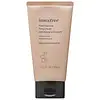What's inside
What's inside
 Key Ingredients
Key Ingredients

 Benefits
Benefits

 Concerns
Concerns

 Ingredients Side-by-side
Ingredients Side-by-side

Water
Skin ConditioningGlycerin
HumectantMyristic Acid
CleansingStearic Acid
CleansingPEG-32
HumectantPotassium Hydroxide
BufferingButylene Glycol
HumectantPalmitic Acid
EmollientLauric Acid
CleansingHydrated Silica
AbrasiveLauryl Glucoside
CleansingGlyceryl Stearate
EmollientPEG-100 Stearate
Cocamidopropyl Betaine
CleansingParfum
MaskingZea Mays Starch
AbsorbentPolyquaternium-7
Sodium Chloride
MaskingMannitol
HumectantMicrocrystalline Cellulose
AbsorbentDisodium EDTA
Sodium Benzoate
MaskingVolcanic Ash
AbrasiveSilica
AbrasiveLactic Acid
BufferingWater, Glycerin, Myristic Acid, Stearic Acid, PEG-32, Potassium Hydroxide, Butylene Glycol, Palmitic Acid, Lauric Acid, Hydrated Silica, Lauryl Glucoside, Glyceryl Stearate, PEG-100 Stearate, Cocamidopropyl Betaine, Parfum, Zea Mays Starch, Polyquaternium-7, Sodium Chloride, Mannitol, Microcrystalline Cellulose, Disodium EDTA, Sodium Benzoate, Volcanic Ash, Silica, Lactic Acid
Water
Skin ConditioningSilica
AbrasiveButylene Glycol
HumectantBenzyl Alcohol
PerfumingMannitol
HumectantAlcohol Denat.
AntimicrobialXanthan Gum
EmulsifyingCellulose
AbsorbentLavandula Angustifolia Oil
MaskingGlycolic Acid
BufferingMenthone Glycerin Acetal
RefreshingEnantia Chlorantha Bark Extract
Skin ConditioningSodium Hydroxide
BufferingDisodium EDTA
Glycerin
HumectantSalicylic Acid
MaskingOleanolic Acid
Skin ConditioningAcrylates Copolymer
Caprylic/Capric Triglyceride
MaskingTocopheryl Acetate
AntioxidantHydroxypropyl Methylcellulose
Emulsion StabilisingIris Florentina Root Extract
MaskingSodium Benzoate
MaskingPotassium Sorbate
PreservativeRosa Multiflora Fruit Extract
MaskingCI 77007
Cosmetic ColorantCI 77891
Cosmetic ColorantCI 77120
Cosmetic ColorantWater, Silica, Butylene Glycol, Benzyl Alcohol, Mannitol, Alcohol Denat., Xanthan Gum, Cellulose, Lavandula Angustifolia Oil, Glycolic Acid, Menthone Glycerin Acetal, Enantia Chlorantha Bark Extract, Sodium Hydroxide, Disodium EDTA, Glycerin, Salicylic Acid, Oleanolic Acid, Acrylates Copolymer, Caprylic/Capric Triglyceride, Tocopheryl Acetate, Hydroxypropyl Methylcellulose, Iris Florentina Root Extract, Sodium Benzoate, Potassium Sorbate, Rosa Multiflora Fruit Extract, CI 77007, CI 77891, CI 77120
 Reviews
Reviews

Ingredients Explained
These ingredients are found in both products.
Ingredients higher up in an ingredient list are typically present in a larger amount.
Butylene Glycol (or BG) is used within cosmetic products for a few different reasons:
Overall, Butylene Glycol is a safe and well-rounded ingredient that works well with other ingredients.
Though this ingredient works well with most skin types, some people with sensitive skin may experience a reaction such as allergic rashes, closed comedones, or itchiness.
Learn more about Butylene GlycolDisodium EDTA plays a role in making products more stable by aiding other preservatives.
It is a chelating agent, meaning it neutralizes metal ions that may be found in a product.
Disodium EDTA is a salt of edetic acid and is found to be safe in cosmetic ingredients.
Learn more about Disodium EDTAGlycerin is already naturally found in your skin. It helps moisturize and protect your skin.
A study from 2016 found glycerin to be more effective as a humectant than AHAs and hyaluronic acid.
As a humectant, it helps the skin stay hydrated by pulling moisture to your skin. The low molecular weight of glycerin allows it to pull moisture into the deeper layers of your skin.
Hydrated skin improves your skin barrier; Your skin barrier helps protect against irritants and bacteria.
Glycerin has also been found to have antimicrobial and antiviral properties. Due to these properties, glycerin is often used in wound and burn treatments.
In cosmetics, glycerin is usually derived from plants such as soybean or palm. However, it can also be sourced from animals, such as tallow or animal fat.
This ingredient is organic, colorless, odorless, and non-toxic.
Glycerin is the name for this ingredient in American English. British English uses Glycerol/Glycerine.
Learn more about GlycerinMannitol is a sugar alcohol. It is a humectant and moisturizes the skin. In vitro (not tested on a living organism), mannitol displays antioxidant properties.
When found in aqueous solutions, mannitol tends to become acidic. This is because it loses a hydrogen ion. This is why mannitol can often be found with pH adjusting ingredients, such as sodium bicarbonate.
Fun fact: Mannitol can be found in foods as a sweetener. It can be naturally found in mushrooms, algae, fruits, and veggies.
Learn more about MannitolSilica, also known as silicon dioxide, is a naturally occurring mineral. It is used as a fine, spherical, and porous powder in cosmetics.
Though it has exfoliant properties, the function of silica varies depending on the product.
The unique structure of silica enhances the spreadability and adds smoothness, making it a great texture enhancer.
It is also used as an active carrier, emulsifier, and mattifier due to its ability to absorb excess oil.
In some products, tiny microneedles called spicules are made from silica or hydrolyzed sponge. When you rub them in, they lightly polish away dead skin layers and enhance the penetration of active ingredients.
Learn more about SilicaSodium Benzoate is a preservative. It's used in both cosmetic and food products to inhibit the growth of mold and bacteria. It is typically produced synthetically.
Both the US FDA and EU Health Committee have approved the use of sodium benzoate. In the US, levels of 0.1% (of the total product) are allowed.
Sodium benzoate works as a preservative by inhibiting the growth of bacteria inside of cells. It prevents the cell from fermenting a type of sugar using an enzyme called phosphofructokinase.
It is the salt of benzoic acid. Foods containing sodium benzoate include soda, salad dressings, condiments, fruit juices, wines, and snack foods.
Studies for using ascorbic acid and sodium benzoate in cosmetics are lacking, especially in skincare routines with multiple steps.
We always recommend speaking with a professional, such as a dermatologist, if you have any concerns.
Learn more about Sodium BenzoateWater. It's the most common cosmetic ingredient of all. You'll usually see it at the top of ingredient lists, meaning that it makes up the largest part of the product.
So why is it so popular? Water most often acts as a solvent - this means that it helps dissolve other ingredients into the formulation.
You'll also recognize water as that liquid we all need to stay alive. If you see this, drink a glass of water. Stay hydrated!
Learn more about Water